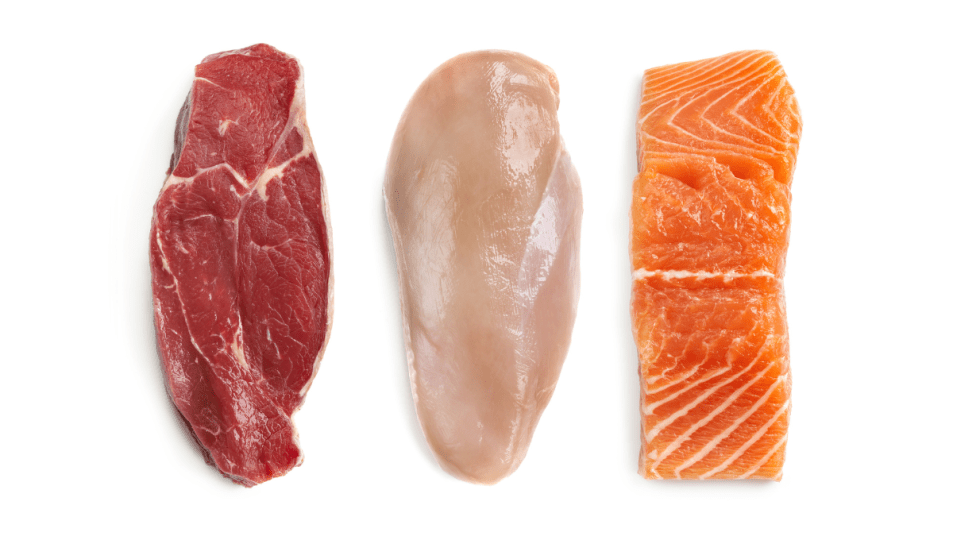From keto to Mediterranean, weight loss diets are so prolific that it can be tempting to jump from one to the next when you don’t see results quickly. This pattern, known as yo-yo dieting, is unhealthy — to say the least. It encourages extreme weight loss (more than half a pound to two pounds per week) and even greater weight gain when the diet ends, as the body struggles to recover from the stress. That’s why, for clients who want to lose weight, most nutritionists and dietitians recommend focusing on the basics instead — calories in, calories expended. But this brings us to a big question: If cutting calories is the focus, does the source of your calories (ie. the kinds of foods you eat) really matter?
According to Michelle Rauch, MS, RDN, and nutrition consultant for the Actors Fund Home in New Jersey, it does — especially when it comes to protein. “In your quest for weight loss, I recommend limiting protein sources that are processed, high in saturated fats, and/or sodium laden,” she says. “Deli meats, such as ham and cured meats, hot dogs, pork sausage, cheese, and bacon will likely not help you reach your weight loss goals if eaten regularly.”
In other words, food is more than just its calories; its quality plays a big role in whether you gain muscle and lose fat, or vice versa. That’s why the type of protein you eat matters a lot. Learn more about each source of protein and how they compare below.
Note: While the traditional serving size for protein is 3 ounces, or the size of a deck of playing cards, we realistically eat more than that to feel satiated. As a result, the serving sizes below are all 6 ounces — grilled, broiled, or poached (no added oils or seasonings).
Chicken
Breast (6 oz): 281 calories, 52 grams protein, 6.1 grams fat, 0 grams carbs
Thigh, skinless, boneless (6 oz): 305 calories, 42 grams protein, 14 grams fat
“When choosing the best proteins to include in your diet, look for those that are on the leaner side,” Rauch advises. “Light meat poultry is lower in fat and contains fewer calories than its dark meat counterpart.”
In this respect — and many others — chicken breast is the clear winner. It contains the highest amount of protein per serving compared to every other protein source listed here. There are a few downsides: It’s difficult to cook without drying out, and it can become boring if you don’t find new ways of seasoning it. (To solve those problems, check out these tricks for keeping it moist, and these flavorful chicken breast dinner recipes.) Chicken also isn’t as low fat as certain types of fish, and fish fat is healthier, according to Rauch. Still, chicken breast’s nutritional profile makes it clear why this meat is included in just about any weight loss diet.
Beef
Steak, ribeye, grilled (6 oz): 460 calories, 42 grams protein, 32 grams fat, 0 grams carbs
Hamburger, ground beef, 20 percent fat (6 oz): 460 calories, 42 grams protein, 32 grams fat
Rauch recommends limiting your red meat intake if you are trying to lose weight. Compared to the fat content of chicken, beef fat is noticeably high. However, you don’t have to give up red meat completely.
“Beef can be included in moderation if you select lean cuts,” says Rauch. “Beef is high in saturated fat, which is why it should be limited to no more than one or two servings (3 ½ to 4 ounce servings) weekly. Cuts such as sirloin, top round, and eye of round roast — where there is little or no marbling — are the best choices. When choosing ground beef, look for ground sirloin (90 to 95 percent lean meat).”
Fish
Salmon (6 oz): 216 calories, 35 grams protein, 7.5 grams fat, 0 grams carbs
Cod (6 oz): 136 calories, 30 grams protein, 1.5 grams fat, 0 grams carbs
Flounder (6 oz): 121 calories, 26 grams protein, 3 grams fat, 0 grams carbs
Tilapia (6 oz): 163 calories, 34 grams protein, 3 grams fat, 0 grams carbs
Tuna, canned (6 oz): 197 calories, 43 grams protein, 1.4 grams fat, 0 grams carbs
As Rauch notes, fish is another excellent protein source for a weight loss diet. “Fish is a high-quality protein that is low in saturated fats,” she says. “The fat found in fish comes in the form of omega-3 fatty acids. So, the combination of ‘good’ fats and protein makes it an excellent choice if you are trying to eat healthier and lose weight. Some of the best choices? Lean white fish, such as cod and flounder. Salmon and tuna are also excellent sources of protein.”
Tofu
Firm tofu (6 oz): 180 calories, 18 grams protein, 9 grams fat, 6 grams carbs
Silken tofu (6 oz): 80 calories, 8 gram protein, 4 grams fat, 4 grams carbs
If you’re looking for variety or you are vegetarian, tofu — made from soybeans — is an important source of protein to have in your diet. “It is a complete protein, which means that it contains all nine essential amino acids,” says Rauch. “Tofu comes in a variety of textures from silken to firm, and it takes on the flavor of what you marinate it in or cook with it. This makes it another versatile ingredient to add to a meal.” Keep in mind that silken tofu has noticeably less protein per serving than firm.
Seitan
Strips (6 oz): 240 calories, 42 grams protein, 4 grams fat, 10 grams carbs
Seitan (pronounced “say-tan”) might be unfamiliar to you, but it is highly nutritious — and it contains the same amount of protein in 6 ounces as beef or chicken thighs. “Seitan is made from wheat gluten and mimics the texture of meat with an umami taste,” says Rauch. “By itself, the flavor is mild, so you’ll want to add marinades or sauces.” This meat alternative is also a complete protein source, though it doesn’t have much lysine (an essential amino acid). A simple fix: Eat it with lysine-rich foods, like beans, peas, or lentils.
Tempeh
Strips (6 oz): 326 calories, 34.5 grams protein, 18 grams fat, 13 grams carbs
Made from cooked and soaked soybeans (and sometimes brown rice, as well) that have been formed into a block, tempeh (pronounced “tem-pay”) is another excellent meat alternative. It’s also a complete protein, and has little to no saturated fat. “Similar to tofu as it takes on the flavor of whatever you cook with it, tempeh has a nuttier flavor than tofu, and it’s textured,” explains Rauch. Season it as you would any other protein source, though it’s particularly delicious in a stir fry.
How Much Protein You Should Eat in a Day
Unfortunately, there’s no one-size-fits-all recommendation for how much protein you should eat daily on a weight loss diet. “The Recommended Daily Amount (RDA) for protein is determined by multiple factors, including but not limited to: weight, activity level, age, and muscle mass,” explains Rauch. “The RDAs have been set by the Food and Nutrition Board since 1941. The estimated requirements set for protein is 0.8g per kilograms body weight, daily.” For an estimate of how much protein you should eat based on your activity level, try this protein calculator.
Final Verdict
While there isn’t one protein source that is best for weight loss, a few stand out as front runners: chicken breast, fish, and seitan. Chicken breast has the most protein per serving, while fish is lower in calories and contains omega-3 fatty acids. Seitan is an excellent meat alternative because of its high protein content, though its important to eat it with foods high in lysine. No matter what type of protein you eat weekly, watch your seasonings — fatty and salty marinades can set you back in your quest to lead a healthier lifestyle.




